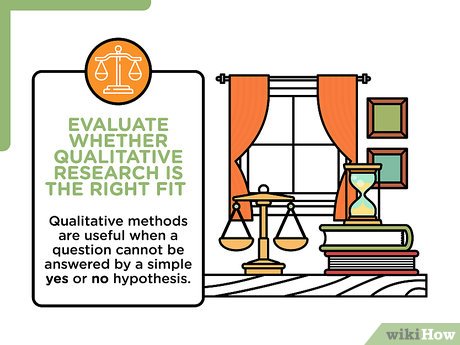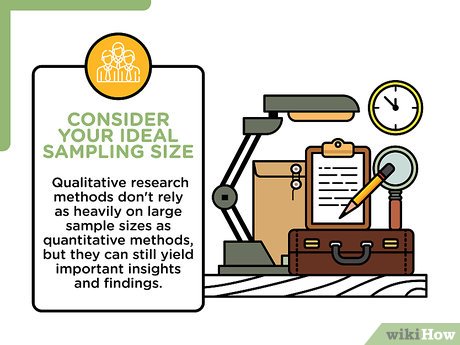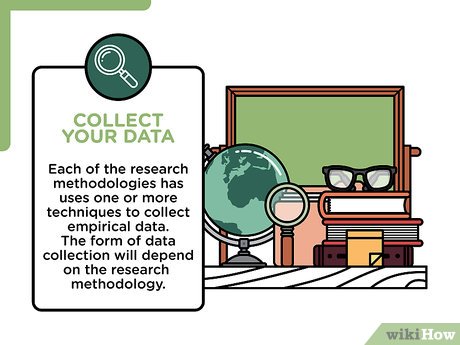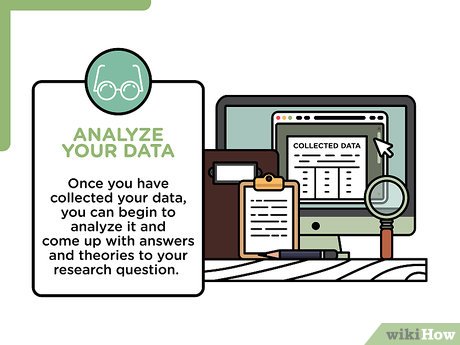How to Do Qualitative Research
Part 1 of 2:
Preparing Your Research
-
 Decide on a question you want to study. A good research question needs to be clear, specific, and manageable. To do qualitative research, your question should explore reasons for why people do things or believe in something.
Decide on a question you want to study. A good research question needs to be clear, specific, and manageable. To do qualitative research, your question should explore reasons for why people do things or believe in something.- The research questions is one of the most important pieces of your research design. It determines what you want to learn or understand and also helps to focus the study, since you can't investigate everything at once. Your research question will also shape how you conduct your study since different questions require different methods of inquiry.
- You should start with a burning question and then narrow it down more to make it manageable enough to be researched effectively. For example, "what is the meaning of teachers' work to teachers" is too broad for a single research endeavor, but if that's what you're interested you could narrow it by limiting the type of teacher or focusing on one level of education. For example, "what is the meaning of teachers' work to second career teachers?" or "what is the meaning of teachers' work to junior high teachers?"
Tip: Find the balance between a burning question and a researchable question. The former is something you really want to know about and is often quite broad. The latter is one that can be directly investigated using available research methods and tools.
-
 Do a literature review. A literature review is a process of studying what others have written about your research question and particular topic. You read widely on the larger field and examine studies that relate to your topic. You then draw up an analytical report that synthesizes and integrates the existing research (rather than simply presents a short summary of each study in chronological order. In other words, you are "researching the research."
Do a literature review. A literature review is a process of studying what others have written about your research question and particular topic. You read widely on the larger field and examine studies that relate to your topic. You then draw up an analytical report that synthesizes and integrates the existing research (rather than simply presents a short summary of each study in chronological order. In other words, you are "researching the research."
[2]- For example, if your research question focuses on how second career teachers attribute meaning to their work, you would want to examine the literature on second career teaching - what motivates people to turn to teaching as a second career? How many teachers are in their second career? Where do most second career teachers work? Doing this reading and review of existing literature and research will help you refine your question and give you the base you need for your own research. It will also give you a sense of the variables that might impact your research (e.g., age, gender, class, etc.) and that you will need to take into consideration in your own study.
- A literature review will also help you to determine whether you are really interested and committed to the topic and research question and that there is a gap in the existing research that you want to fill by conducting your own investigation.
-
 Evaluate whether qualitative research is the right fit for your research question. Qualitative methods are useful when a question cannot be answered by a simple 'yes' or no' hypothesis. Often qualitative research is especially useful for answering "how" or "what" questions.[3] They are also useful when budgetary decisions have to be taken into account.
Evaluate whether qualitative research is the right fit for your research question. Qualitative methods are useful when a question cannot be answered by a simple 'yes' or no' hypothesis. Often qualitative research is especially useful for answering "how" or "what" questions.[3] They are also useful when budgetary decisions have to be taken into account.For example, if your research question is "what is the meaning of teachers' work to second career teachers?", that is not a question that can be answered with a 'yes' or 'no'. Nor is there likely to be a single overarching answer. This means that qualitative research is the best route.
-
 Consider your ideal sampling size. Qualitative research methods don't rely as heavily on large sample sizes as quantitative methods, but they can still yield important insights and findings.[4] For instance, since it's unlikely that you have the funding to be able to study all second teachers everywhere in the United States, perhaps you choose to narrow your study to a major urban area (like New York) or schools within 200km of where you live.
Consider your ideal sampling size. Qualitative research methods don't rely as heavily on large sample sizes as quantitative methods, but they can still yield important insights and findings.[4] For instance, since it's unlikely that you have the funding to be able to study all second teachers everywhere in the United States, perhaps you choose to narrow your study to a major urban area (like New York) or schools within 200km of where you live.- Consider the possible outcomes. Because qualitative methodologies are generally quite broad, there is almost always the possibility that some useful data will come out of the research. This is different than in a quantitative experiment, where an unproven hypothesis can mean that a lot of time has been wasted.[5]
- Your research budget and available financial resources should also be considered. Qualitative research is often cheaper and easier to plan and execute. For example, it is usually easier and cost-saving to gather a small number of people for interviews than it is to purchase a computer program that can do statistical analysis and hire the appropriate statisticians.[6]
-
 Choose a qualitative research methodology. The design of qualitative research is the most flexible of all the experimental techniques, so there are a number of accepted methodologies available to you.[7]
Choose a qualitative research methodology. The design of qualitative research is the most flexible of all the experimental techniques, so there are a number of accepted methodologies available to you.[7]- Action Research – Action research focuses on solving an immediate problem or working with others to solve problem and address particular issues.[8]
- Ethnography – Ethnography is the study of human interaction in communities through direct participation and observation within the community you wish to study. Ethnographic research comes from the discipline of social and cultural anthropology but is now becoming more widely used.[9]
- Phenomenology – Phenomenology is the study of the subjective experiences of others. It researches the world through the eyes of another person by discovering how they interpret their experiences.[10]
- Grounded Theory – The purpose of grounded theory is to develop theory based on the data systematically collected and analyzed. It looks at specific information and derives theories and reasons for the phenomena.
- Case Study Research – This method of qualitative study is an in-depth study of a specific individual or phenomena in its existing context.[11]
Part 2 of 2:
Collecting and Analyzing Your Data
-
 Collect your data. Each of the research methodologies has uses one or more techniques to collect empirical data, including interviews, participant observation, fieldwork, archival research, documentary materials, etc. The form of data collection will depend on the research methodology. For example, case study research usually relies on interviews and documentary materials, whereas ethnography research requires considerable fieldwork.[12]
Collect your data. Each of the research methodologies has uses one or more techniques to collect empirical data, including interviews, participant observation, fieldwork, archival research, documentary materials, etc. The form of data collection will depend on the research methodology. For example, case study research usually relies on interviews and documentary materials, whereas ethnography research requires considerable fieldwork.[12]- Direct observation – Direct observation of a situation or your research subjects can occur through video tape playback or through live observation. In direct observation, you are making specific observations of a situation without influencing or participating in any way.[13] For example, perhaps you want to see how second career teachers go about their routines in and outside the classrooms and so you decide to observe them for a few days, being sure to get the requisite permission from the school, students and the teacher and taking careful notes along the way.
- Participant observation – Participant observation is the immersion of the researcher in the community or situation being studied. This form of data collection tends to be more time consuming, as you need to participate fully in the community in order to know whether your observations are valid.[14]
- Interviews – Qualitative interviewing is basically the process of gathering data by asking people questions. Interviewing can be very flexible - they can be on-on-one, but can also take place over the phone or Internet or in small groups called "focus groups". There are also different types of interviews. Structured interviews use pre-set questions, whereas unstructured interviews are more free-flowing conversations where the interviewer can probe and explore topics as they come up. Interviews are particularly useful if you want to know how people feel or react to something. For example, it would be very useful to sit down with second career teachers in either a structured or unstructured interview to gain information about how they represent and discuss their teaching careers.
- Surveys – Written questionnaires and open ended surveys about ideas, perceptions, and thoughts are other ways by which you can collect data for your qualitative research. For example, in your study of second career schoolteachers, perhaps you decide to do an anonymous survey of 100 teachers in the area because you're concerned that they may be less forthright in an interview situation than in a survey where their identity was anonymous.
- "Document analysis" – This involves examining written, visual, and audio documents that exist without any involvement of or instigation by the researcher. There are lots of different kinds of documents, including "official" documents produced by institutions and personal documents, like letters, memoirs, diaries and, in the 21st century, social media accounts and online blogs. For example, if studying education, institutions like public schools produce many different kinds of documents, including reports, flyers, handbooks, websites, curricula, etc. Maybe you can also see if any second career teachers have an online meet group or blog. Document analysis can often be useful to use in conjunction with another method, like interviewing.
-
 Analyze your data. Once you have collected your data, you can begin to analyze it and come up with answers and theories to your research question. Although there are a number of ways to analyze your data, all modes of analysis in quantitative research are concerned with textual analysis, whether written or verbal.[15]
Analyze your data. Once you have collected your data, you can begin to analyze it and come up with answers and theories to your research question. Although there are a number of ways to analyze your data, all modes of analysis in quantitative research are concerned with textual analysis, whether written or verbal.[15]- Coding – In coding, you assign a word, phrase, or number to each category. Start out with a pre-set list of codes that you derived from your prior knowledge of the subject. For example, "financial issues" or "community involvement" might be two codes you think of after having done your literature review of second career teachers. You then go through all of your data in a systematic way and "code" ideas, concepts and themes as they fit categories. You will also develop another set of codes that emerge from reading and analyzing the data. For example, you may see while coding your interviews, that "divorce" comes up frequently. You can add a code for this. Coding helps you organize your data and identify patterns and commonalities.[16]
- Descriptive Statistics – You can analyze your data using statistics. Descriptive statistics help describe, show or summarize the data to highlight patterns. For example, if you had 100 principal evaluations of teachers, you might be interested in the overall performance of those students. Descriptive statistics allow you to do that. Keep in mind, however, that descriptive statistics cannot be used to make conclusions and confirm/disprove hypotheses.[17]
- Narrative analysis – Narrative analysis focuses on speech and content, such as grammar, word usage, metaphors, story themes, meanings of situations, the social, cultural and political context of the narrative.[18]
- Hermeneutic Analysis – Hermeneutic analysis focuses on the meaning of a written or oral text. Essentially, you are trying to make sense of the object of study and bring to light some sort of underlying coherence.[19]
- Content analysis/Semiotic analysis – Content or semiotic analysis looks at texts or series of texts and looks for themes and meanings by looking at frequencies of words. Put differently, you try to identify structures and patterned regularities in the verbal or written text and then make inferences on the basis of these regularities.[20] For example, maybe you find the same words or phrases, like "second chance" or "make a difference," coming up in different interviews with second career teachers and decide to explore what this frequency might signify.
-
 Write up your research. When preparing the report on your qualitative research, keep in mind the audience for whom you are writing and also the formatting guidelines of the research journal you wish to submit your research to. You will want to make sure that your purpose for your research question is compelling and that you explain your research methodology and analysis in detail.
Write up your research. When preparing the report on your qualitative research, keep in mind the audience for whom you are writing and also the formatting guidelines of the research journal you wish to submit your research to. You will want to make sure that your purpose for your research question is compelling and that you explain your research methodology and analysis in detail.
4.5 ★ | 2 Vote
You should read it
- How to Become a Teacher of Hearing Impaired Students
- Good poems for teachers on the day of Vietnamese teachers
- Summary of good 20-11 wishes for teachers
- Good lyrics and meaning about Vietnamese teachers' day
- How to Record Attendance of Employees
- Suggest ways to choose meaningful gifts for teachers on November 20
- How to Become an Educational Consultant
- 10 profound lessons about life we will learn from teachers
May be interested
- Smart toilets can identify your 'backhole' and take photos for research scientists
 face recognition is old, now there's anal recognition too, of course, for scientific research.
face recognition is old, now there's anal recognition too, of course, for scientific research. - 8 Ways to Use ChatGPT's Deep Research Tool
 knowing how to get the most out of chatgpt's deep research tool will take your project to the next level, and there are some helpful tips to help you do just that.
knowing how to get the most out of chatgpt's deep research tool will take your project to the next level, and there are some helpful tips to help you do just that. - How to turn off Research in Excel
 the research tool in excel is activated with the alt key + left mouse button. if you do not need to use research in excel, you can completely turn off this tool according to the instructions below.
the research tool in excel is activated with the alt key + left mouse button. if you do not need to use research in excel, you can completely turn off this tool according to the instructions below. - How to Publish a Research Paper
 publishing a research paper in a peer-reviewed journal is an important activity within the academic community. it allows you to network with other scholars, get your name and work into circulation, and further refine your ideas and...
publishing a research paper in a peer-reviewed journal is an important activity within the academic community. it allows you to network with other scholars, get your name and work into circulation, and further refine your ideas and... - ReactOS - 'an unauthorized copy of the Windows Research Kernel'
 reactos is the perfect copy of the windows research kernel that microsoft once licensed to use in previous universities and educational institutions.
reactos is the perfect copy of the windows research kernel that microsoft once licensed to use in previous universities and educational institutions. - How Scholar GPT Works: Custom GPT Searches for More Up-to-Date Information Deep Research
 despite its many advantages, chatgpt's deep research tool still has some major drawbacks. scholar gpt, a custom gpt, can help you solve this problem.
despite its many advantages, chatgpt's deep research tool still has some major drawbacks. scholar gpt, a custom gpt, can help you solve this problem. - Warning: New research has identified the corona virus to remain on the mask for more than a week
 new research shows that the time the virus remains on the face of the mask is much longer than we thought. therefore, all need to make it a habit not to touch the front of the mask after use, and wash their hands often.
new research shows that the time the virus remains on the face of the mask is much longer than we thought. therefore, all need to make it a habit not to touch the front of the mask after use, and wash their hands often. - Research proves: Traveling makes you smarter and healthier
 here is the study proving that traveling helps you be smarter and healthier. invite everyone to consult!
here is the study proving that traveling helps you be smarter and healthier. invite everyone to consult! - 6 Reasons Obsidian is Used for In-Depth Research Projects
 research projects can get messy quickly, so having the right tool is essential—one that seamlessly connects your thoughts and ideas while still being easy to use.
research projects can get messy quickly, so having the right tool is essential—one that seamlessly connects your thoughts and ideas while still being easy to use. - 5 common mistakes when researching keywords for SEO
 avoiding these errors can save you time, rethink your marketing strategy and bring the right audience to your website.
avoiding these errors can save you time, rethink your marketing strategy and bring the right audience to your website.


















 How to Help Others
How to Help Others How to Discover Your Talents
How to Discover Your Talents How to Speak American English
How to Speak American English How to Create a Successful Project (for School)
How to Create a Successful Project (for School) How to Start a Conclusion Paragraph
How to Start a Conclusion Paragraph How to Write About Your Hobbies and Interests
How to Write About Your Hobbies and Interests